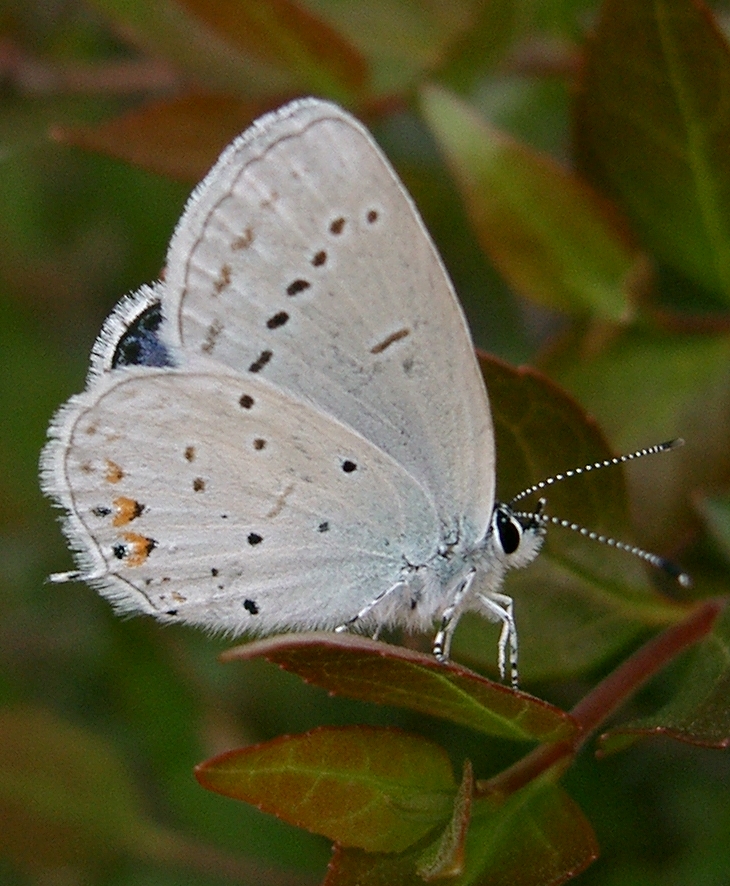- Elkalyce argiades
image_width = 200px
image_caption = Photographed in Osaka, Japan
regnum =Animal ia
phylum =Arthropod a
classis =Insect a
ordo =Lepidoptera
superfamilia =Papilionoidea
familia =Lycaenidae
genus = "Elkalyce "
species = "E. argiades"
binomial = "Elkalyce argiades"
binomial_authority = (Pallas 1771)The Tailed Cupid ("Elkalyce argiades") is a small
butterfly found inAsia that belongs to the Lycaenids or Blues family.Description
A very variable form especially in the colouring on the upper-side in the female.
Male Upperside: violet of lighter or darker shade. Fore wing: a terminal edging of brown of varying width and an obscure anticiliary black line; costal generally with a very narrow line of brown; cilia brown at base, white outwardly. Hind wing: costal margin more or less broadly brown, this brown edging continued in some specimens down the termen to the tornal angle, in others only for a short distance or not at all; subterminal black spots in the posterior three or four interspaces, the one in interspace 2 largest, the two in interspace 1 minute, sometimes geminate; generally the spots are outwardly edged very narrowly with white; finally, an anticiliary slender black line much more prominent than on the forewing; tail black tipped with white. Underside: white to brownish grey, the markings sometimes prominent, very often pale and faint, those constituting the discal bands on both fore and hind wings round and black, or transverse, linear and pale brownish. Fore wing: a short transverse line on the discocellulars; a transverse discal row of spots followed by an inner and an outer sub-terminal maculate band which may be slender and well marked or with the inner band broad and each spot composing it diffuse; finally, an anticiliary very slender black line Hind wing: a transverse subbasal series of two sometimes three black spots; a slender short brownish line on the discocellulars; a transverse, discal, bisinuate series of black spots followed by a somewhat obscure postdiscal transverse series of black or pale brownish lunules, a subterminal series of black spots and a slender anticiliary black line; the subterminal portions of interspaces 2 and 3, sometimes of 4 and 5 also, that lie between postdiscal series of lunules and the outer edge of the subterminal row of spots ochraceous yellow, the spots themselves in interspaces 2 and 3 much larger than the others. Antenna black, the shafts speckled as usual with white; head, thorax and abdomen brown, with a pale purplish flush on the thorax and abdomen in fresh specimens ; beneath : palpi, thorax and abdomen white or grey.
Female upperside: in the commonest form dark greyish-blue. Fore wing: the costa, apex and termen very broadly fuscous-black, with an obscure black anticiliary line as in the male. Hind wing: as in the male but the costal dusky brownish-black edging much broader, always more or less continued along the termen; the subterminal rows of spots often nearly complete to apex, those in interspaces 2 and 3 very large and crowned inwardly with ochraceous yellow, in some specimens more or less obsolescent. Specimens of the female with the ground-colour on the upperside entirely brown and the terminal markings on the hind wing indistinct are not uncommon. Underside: as in the male, the markings on the whole more distinct. Antennae, head, thorax and abdomen as in the male, but without the purplish flush seen on some specimens of the latter.
Specimens from very dry localities in Upper Burma and from Great Nicobar Island are remarkably small and pale, with the markings on the underside, especially the subtornal ochraceous yellow patch, more or less obsolescent.Bingham, C. T. 1907. Fauna of British India. Butterflies. Volume 2]
Distribution
The Holarctic region, Oriental region and Notogaean realm.
Life cycle
Larva. "Pale green with a darker dorsal stripe, dark lateral streaks, and light brown and white spots. Feeds on trefoil and other Leguminosae" (Lang.)Pupa. "Longer and slenderer than in "Cyaniris", being nearly four times longer than broad, the abdomen but slightly more elevated than the thorax, and the whole body covered with long distant hairs, by which they may be readily distinguished; in colour they resemble the caterpillar, or are darker and spotted with black." (Scudder.)
References
ee also
*
Lycaenidae
*List of butterflies of India
*List of butterflies of India (Lycaenidae)
Wikimedia Foundation. 2010.

